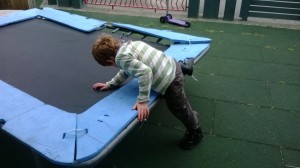Jacob is a 6 year old boy who attends a special school. He has complex needs which includes being deafblind.
To assist his hearing, Jacob has recently had an operation for a cochlear implant and he is working towards understanding what sounds are and what they mean.
To help Jacob learn what is happening during his day, he has been working with his BLENNZ Resource Teacher: Vision, Baukje de Jong and his class teacher to understand the pre-braille concepts of up and down. In figure 1 Jacob is climbing on to the trampoline.
Coactive signing
Using the coactive signs and words for up and down, different scenarios were created for Jacob to experience what these words/signs meant. During the day, when the word for up was used, we said “Up, up, up” in an upbeat, higher voice and/or signing ‘up’ usually underneath his hands.
When the word down was used, we said “D-o-w-n, d-o-w-n, d-o-w-n” in a slower, lower voice. We coactively signed ‘down’ again on Jacob’s hands. In figure 2 Jacob is rolling up and down on a swiss ball.
Prerequisite skills
Since the cochlear implant surgery, Jacob has been much more interested in movement and exploring his environment. He needed to become confident in knowing his surroundings and testing out his limits independently, before he could be encouraged to respond to the coactive signs and word sounds of up and down.
Jacob also needed to be able to hear the sounds of the words, therefore beginning to relate them to something. In figure 3 Jacob is exploring the bubbles.
Possible next steps
- Provide more experiences for Jacob to understand the meaning of up and down.
- Try activities where Jacob puts his hands, and not just his body, up or down.
- Using coactive signing and words to see if Jacob will respond independently.
- Introduce the next concepts of stop and go.
Teaching methods and strategies
- Whenever Jacob needed to stand or sit, the coactive sign and words were used.
- When Jacob was playing on equipment such as the trampoline, swing or see-saw, he would hear the words up or down being spoken to him.
- In all other everyday activities, if there was a time to use the words up or down, Jacob would hear them and/or feel them through coactive signing.
- Working collaboratively with his Cochlear Implant Habilitationist to understand how to use words for learning, as he does not yet understand what words mean.
- “Well done” was signed and said to Jacob when he responded positively to the signals for the words.
Learning adaptations
- Enabling Jacob to be in different environments, such as the play equipment outside, to experience up and down. This allowed Jacob to ‘feel’ the meanings of the words.
- All the staff that worked with Jacob throughout the week were informed of his learning, and encouraged to use the words and signs whenever possible. Therefore Jacob could learn the meanings in different settings.
Assessment
As mentioned earlier, Jacob had become very active and did not want to sit still to explore small items with his hands. After discussion with his teacher, it was decided that we needed to tie his learning into his exploration and general movement around his environment. As Jacob will work toward using Braille as a medium to communicate and receive information, a natural thing for Jacob to learn would be some pre-braille concepts in an active way.
Useful Links
All of these sites discuss a range of activities that can be used with pre-braille children, including the concepts:
- Pre-Braille – Paths to Literacy website.
- Future Reflections: Pre-Braille Experiences for Infants and Toddlers – National Federation of the Blind website.
- Early Literacy for Children with Vision Impairment: Pre-Braille – Guide to Good Health website.
- Coactive Signing – Project Salute website.
- A Co-Active Signal System of Deafblind Children – North Dakota State Government website.
- Children’s singalong Up and Down – YouTube.
- Up/Down Ideas and Resources – a4 Idea People website.
More information
Email us at BLENNZ for more information about this subject. We will link you up with either the author of this post or another BLENNZ colleague with whom you can continue your conversation.



